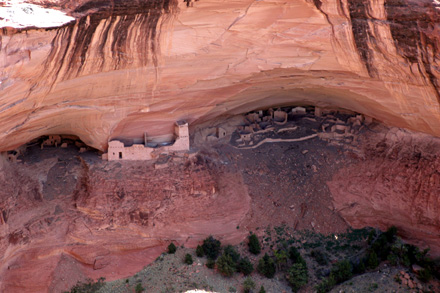Day Trips
Directory of all Day Trips>
Touring the Navajo Nation
by Jaimie Hall-Bruzenak
|
George and I are interested in the geology of the Southwest as well as in the history and culture of the ancestral Puebloans. The Four Corners area, just a few hours from our home base, has a wealth of parks to satisfy those interests. On a recent road trip, we focused on Navajo tribal parks on a loop tour out of Flagstaff, Arizona.
Canyon de Chelly
About three hours from Flagstaff, Canyon de Chelly is not a tribal park, but it sits on Navajo Tribal Trust land; the park is administered by the National Park Service as a national monument. The canyons are still farmed seasonally by about 75 Navajo families. We wanted to explore the two canyons-Canyon del Muerto and Canyon de Chelly- so we booked a Navajo guide through Thunderbird Lodge; without a guide, visitors are confined to the overlooks and to one hiking path down into the canyon to White House Ruins.
The guided tours are conducted from huge four-wheel-drive trucks-actually converted "deuce and a half" military vehicles, which can ford streams and make their way far into the canyons. Benson, our guide, shared Navajo life and history as we stopped at Anasazi ruins, petroglyphs and pictographs. He also pointed out two geologic features important to the Navajo. The first, Navajo Fortress, is a red sandstone butte where a small band of Navajos held out against Kit Carson's troops in 1864. The second, Spider Rock, an 800-foot spire, is home to Spider Woman, who carries off children who disobey their elders.
We spent a second day driving the North and South Rim Drives along both canyons on our own, stopping at each overlook. We also hiked to the White House Ruins.
Four Corners
Southeast of Canyon de Chelly, right on the Arizona-New Mexico border is Window Rock, a tribal park, but instead of backtracking, we continued our loop tour north to Four Corners. We did take a short detour into New Mexico to see Shiprock, an 1,800-foot volcanic plug or vent that looks like an enormous clipper ship under sail and is frequently mentioned in Tony Hillerman's detective books. It was impressive!
At Four Corners we paid an admission fee, then waited our turn to get a photo of each of us crouching with a hand or a foot in each of the four states: Arizona, New Mexico, Colorado and Utah. A large concrete pad with state flags and a view platform mark the only place in the U.S. where the borders of four states meet. Dozens of booths with vendors selling Navajo goods surrounded the monument. George ate Navajo fry bread while I admired the jewelry.
Monument Valley
Our next destination was Monument Valley, right on the border of Utah and Arizona. Approaching Monument Valley from the north on U.S. Highway 163 you can see the tall spires and buttes that are the backdrop for many a western movie. You can drive your vehicle on the loop drive and stop at key formations or book a tour with a Navajo guide that includes the loop drive and a restricted area inside the park.
On the restricted portion of the tour, we saw many geologic windows and arches, a 96-year-old Navajo woman weaving a rug on her loom in her hogan, and another perspective of the valley. Other tours take you to Mystery Valley with its Anasazi ruins, petroglyphs and arches. At full moon, special night tours travel into the valley. Gouldings, across Highway 163, offers lodging and tours.
Antelope Canyon
From Monument Valley we traveled west through the reservation to Antelope Canyon, near Page, in Arizona. Antelope Canyon has been on my list of things to see for years for it is a photographer's paradise. From the air, the canyon opening looks like just a crack in the ground, but inside it's like being immersed in a fantasy world, for the sandstone has been carved into twisty, curved and scalloped formations by eons of flash flooding. Light shining through openings in the crack illuminates the multicolored sculpted sandstone in ever-changing patterns that make for stunning shots.
Several companies in Page offer sightseeing and photography tours in the canyon. The photography tours are longer, and I recommend them. You can take more time getting photos and really savor the beauty. Most photographers consider late morning the best time for lighting, but whenever you go, the guides will help you get good pictures. You can also tour Lower Antelope Canyon, but getting there requires climbing ladders, so it's more strenuous.
From Page, U.S. Highway 89 south takes you back to Flagstaff through the Navajo reservation. Watch for the Painted Desert, whose colorful hues begin south of The Gap and continue almost to Cameron. For a side trip, visit the Little Colorado River Navajo Tribal Park, a short detour off Highway 89. Reach the overlooks by driving 9.4 miles west on State Route 64, the road to the Grand Canyon. The deep, gray-walled gorge is quite unlike the Grand Canyon, and is worth the trip.
We spent two days at Canyon de Chelly, about an hour at Four Corners, and a day each touring Monument Valley and Antelope Canyon. With travel time, you could complete the entire loop in a week.
Jaimie Hall-Bruzenak
6/27/08
(Links updated 2/11/23, RTA)
|
|

